We all faced the problem of a weak signal from the router. Some people immediately think about changing the router, because it seems that the problem is in it. However, this is not quite true. If configured correctly, you can provide good quality Wi-Fi signal connections and coverage. But if you still decide to buy a repeater to amplify the signal, we will help you make the right choice.
What is a Wi-Fi repeater and how does it work?
In this section we will talk about what are called wi-fi signal amplifiers (they are also called repeater, repeater, repeater) and what they are for.
It often happens that having bought and installed a router at home (in the office), you find that the signal does not reach the right place... Of course, you can install the router closer, then the signal will reach the computer, but if this is not possible, you have to buy this device.
The principle of operation of this device is clearly shown in the picture below. It extends the received signal from wi-fi, and directs it to the place you need. At the same time, the Internet speed remains the same.
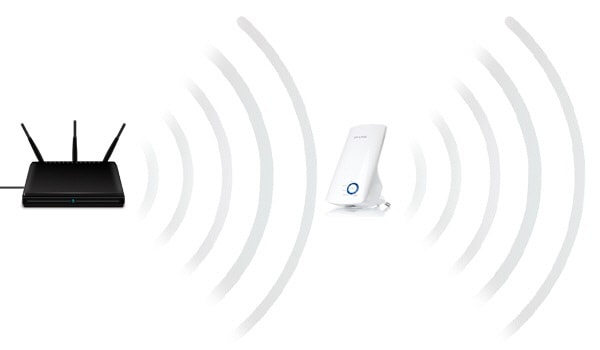 The principle of operation of the signal amplifier for Wi-Fi router
The principle of operation of the signal amplifier for Wi-Fi router
As a rule, this device is quite compact, and works from an ordinary outlet. You can buy it in any online store and install it in your apartment the same day.
Some features of using the amplifier:
- The repeater creates a network similar to the existing one. All your devices (computer, phone, tablet) will automatically connect to the network from which better signal... For example: The router is in the kitchen, and the repeater is in the living room. If you go into the kitchen with your phone, the signal will be received from the router, and into the living room - from the amplifier.
- Can be customized without any problems local area network... All devices will be connected to the same network, regardless of the signal source.
How to strengthen the Wi-fi signal with your own hands?
In general, this device is very useful for the home, however, depending on the model, you will have to shell out a tidy sum for the amplifier. Don't want to spend money? Then use our tips to boost your Wi-Fi signal in your home or office:
1. Place the router in the center of your apartment / office.
Many people install a router in the hallway, or in the farthest room. This is definitely a convenient location, and there is no need to pull the cable throughout the apartment, but because of this, the Internet will suffer greatly. Therefore, we recommend installing the router initially in the room that is equally distant from all the others (as shown in the picture below). If you only need the Internet in one room, then install the router in it. In this case, you do not need to buy a repeater.

The picture shows an example of a good and bad location of a router in an apartment. If you do not want to supply your neighbors with your Internet, then it is better to place the Internet source in the middle of the apartment.
Correct router placement will also help special programs for analysis. WiFi program Analyzer You can measure the points at which the Internet catches the worst and best. Based on the data obtained, it is easier to choose the right place.
2. Change the channel your router is running on.
If you are not the proud owner of a modern dual-band router, then your router operates at 2.4 GHz. The trouble is that there are only 13 channels in this frequency. Among them, you need to select the least loaded one and connect to it. A simple inSSIDer program will help you with this.
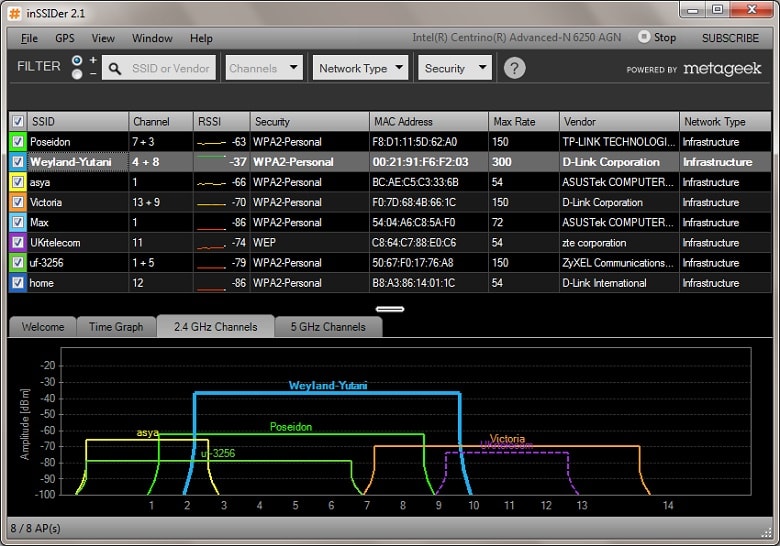
You can download this program completely free of charge. With its help you will see the minimally loaded network. We do not recommend choosing the extreme channels (1st, 2nd, 12th and 13th). As a rule, they are the weakest, so no one wants to connect to them.
Nowadays, every apartment is equipped with high speed internet... Therefore, free channels may simply not be available. If you are unlucky, then move on to the next point.
3. Set the maximum signal strength.
On some models, you can set the strength of the transmitted Wi-Fi signal. You can view this setting in the "Advanced Settings". As a rule, this parameter is set to 100% by default. But the settings could get lost, so it wouldn't hurt to check them.
4. Update your router's firmware.
Go to the manufacturer's website and search there for the latest firmware for your device. If you have a problem from the very beginning, then most likely this is the reason. Manufacturers never fix faults during the development / testing of new devices, so they modify them using new firmware.
5. If all else fails.
TOP 7 best amplifiers for home and office
So we came smoothly to the most important part of our article. Below we will review the most best repeaters 2017 according to users. To do this, we have selected the TOP-5 of the best devices from different manufacturers.
| Category | Name | Rating (based on user reviews) | Price |
|---|---|---|---|
| The best amplifiers in the low price range | 9.5 / 10 | 1,580 ₽ | |
| 9.3 / 10 | 865 ₽ | ||
| 9.5 / 10 | 1 350 ₽ | ||
| The best mid-range amplifiers | 9.5 / 10 | 2 160 ₽ | |
| 9.9 / 10 | 3 590 ₽ | ||
| The best high-end amplifiers | 10 / 10 | 21 140 ₽ | |
| 9.9 / 10 | 11 090 ₽ |
Asus RP-N12
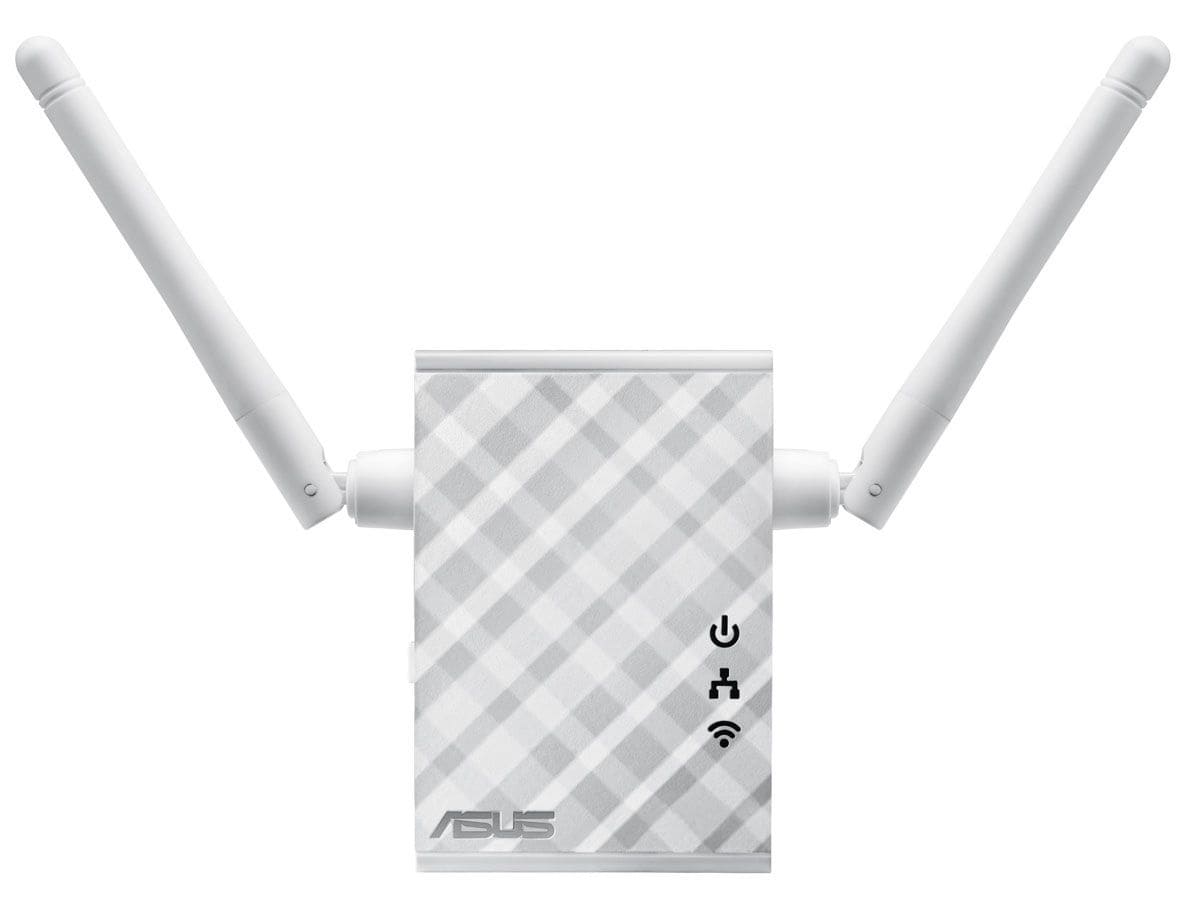
A very good signal amplifier for home and office. Its functionality includes the functions of a repeater, an access point and a network bridge. You can connect it to any outlet in your home, and it is configured with one press of the WPS button. Two powerful antennas will provide an uninterrupted Wi-Fi signal anywhere in the house.
Determine the most optimal placement point this device the indicator on the front panel will help. If the signal from the router is good, the green indicator will be on, if the signal is bad, the red one.
Advantages of the amplifier according to user reviews :
- It is very easy to connect and establish a connection.
- Two powerful antennas that provide a good range.
- Maximum connection speed: 300 Mbps.
disadvantages :
- Sometimes it loses connection with the router, so you have to reboot.
Xiaomi Mi WiFi Amplifier
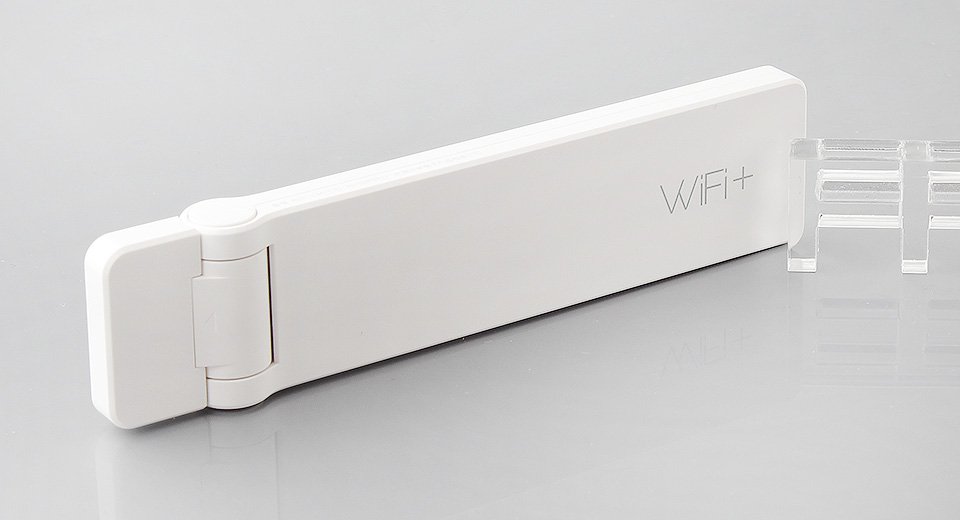
The most compact repeater that you can easily take with you on trips / travels. You can install and configure it in a few minutes. Just plug it in via USB and the device syncs by itself within minutes.
This device is able to double the coverage area of the router. The connection speed with such dimensions is 150 Mbps, which will be sufficient for most routers.
Pros of the repeater according to user reviews :
- A compact device that can be carried in your pocket.
- Almost doubles the coverage area of the router.
- Automatic synchronization.
Minuses :
- Automatic synchronization occurs only with Xiaomi routers. For everyone else, you need to use a special application Xiaomi Smart Home.
TP-Link TL-WA850RE
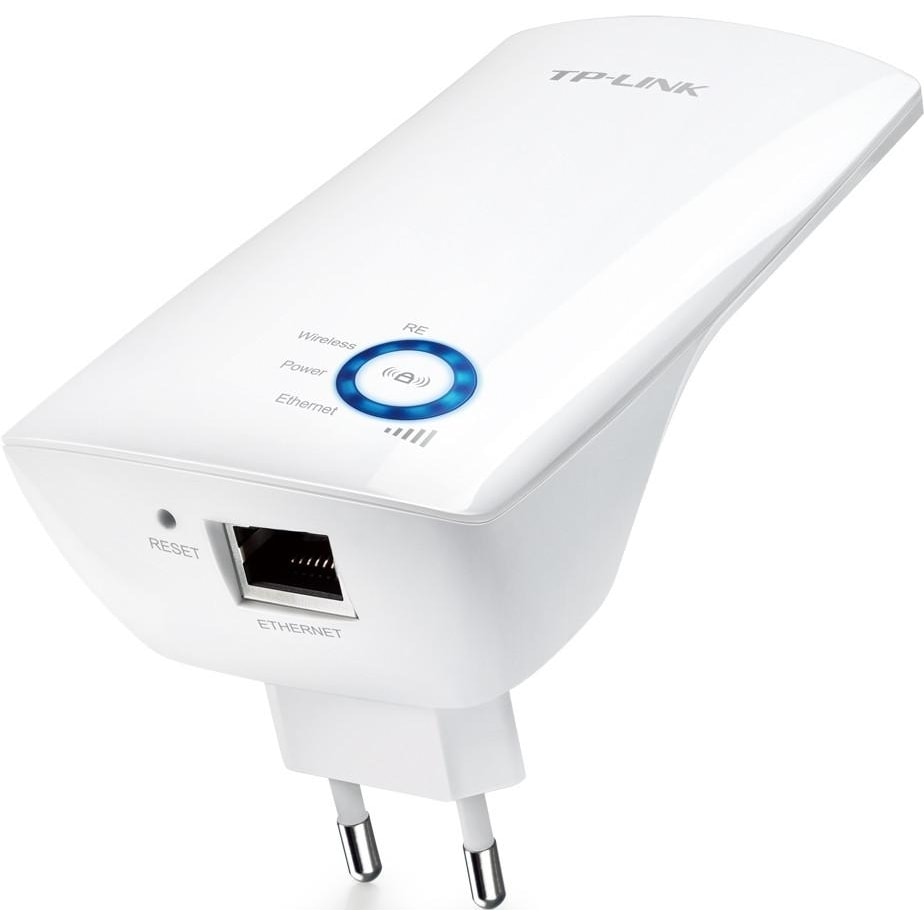
Convenient repeater for your router that will quickly and easily increase the coverage area Wi-Fi signal... It is very easy to connect and configure the device. Plug in and press the Range Extender button on your amplifier and the WPS button on your router.
TP-Link TL-WA850RE will provide the most complete coverage in your apartment, and eliminate dead spots. The signal transmission speed can reach 300 Mbps, which will be enough for games, videos and movies.
pros :
- Easy to set up, can be plugged anywhere.
- Good signal; removes "dead zones" in which there was no Internet.
- Saves the profile so there is no need to reconfigure upon reconnection.
Minuses :
- Not found.
TP-Link AC750
![]()
This repeater will be an excellent option for those who need to increase the signal coverage in two bands. TP-Link AC750 operates in the 2.4 GHz or 5 GHz bands, thus providing data transfer rates up to 750 Mbps.
Connecting an amplifier is easy. Plug it in, press the Range Extender button and the WPS button on the router. After a couple of minutes, the connection will become active. When connected, it completely copies the address of the router.
Advantages :
- Provides full signal coverage over a long distance.
- Quick setup and connection.
- Beautiful design.
- Works stably on two frequency ranges: 2.4 and 5 GHz.
disadvantages :
- High price.
TP-Link Re350
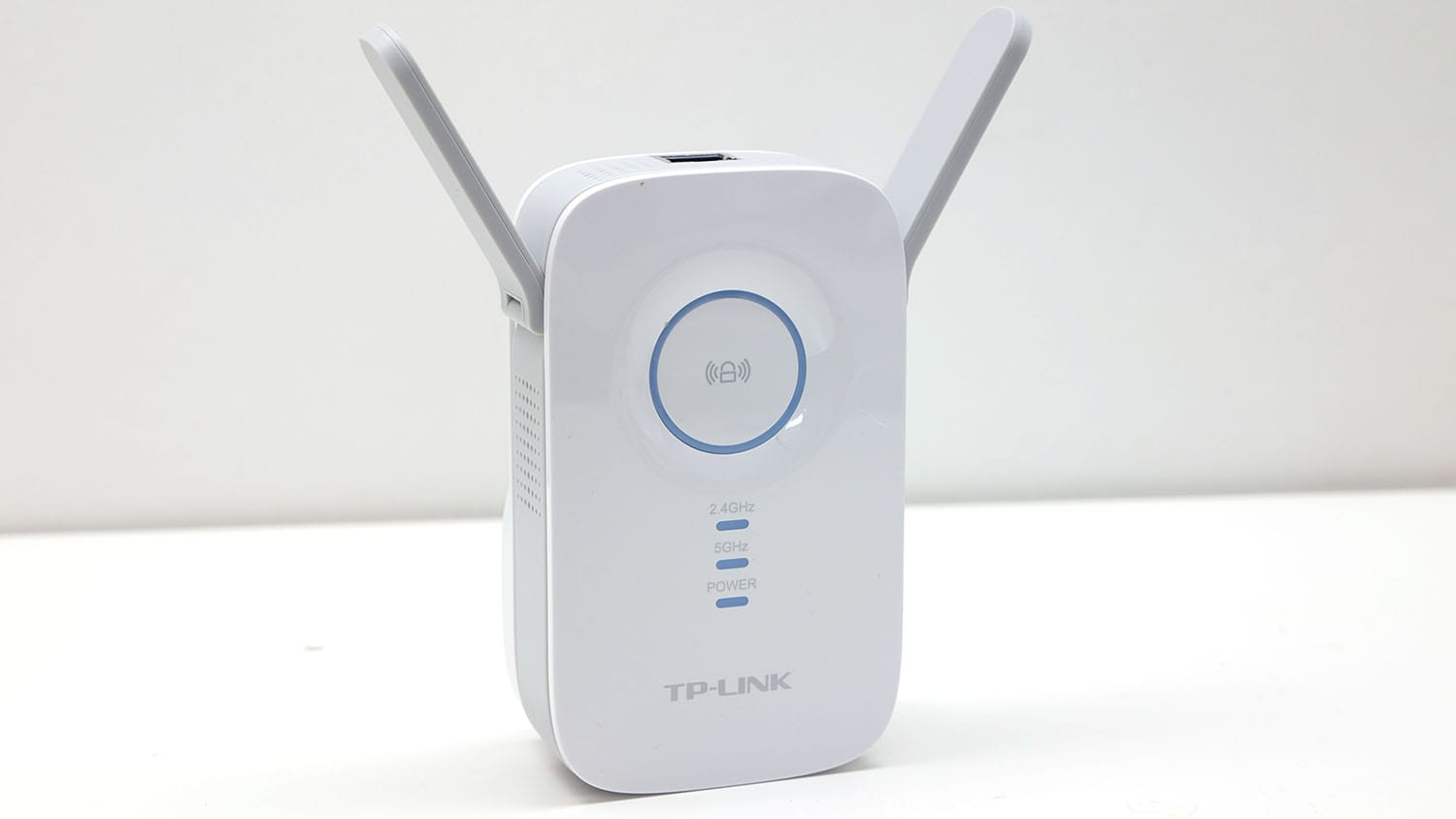
This amplifier is one of the leaders in our rating. It can operate on two frequency bands: 2.4 GHz (speed up to 300 Mbps) and 5 GHz (speed up to 867 Mbps). Installing the amplifier takes a few minutes. Plug it in, sync it with your router, and select the appropriate frequency.
An indicator on the front panel shows the signal strength from the router. If it burns blue light, then the signal level is good enough, and there is no need to reinstall the repeater. If it is red, then connect the amplifier closer to the router. Two antennas provide good Wi-Fi coverage. You can configure TP-Link Re350 to work with almost any router.
Benefits according to user reviews :
- Works on the frequency bands: 2.4 and 5 GHz.
- Thanks to two powerful antennas, it transmits the signal far.
- It is easy to find the optimal repeater position thanks to the LED indicator.
- Beautiful design.
disadvantages :
- High price.
Netgear Orbi AC3000
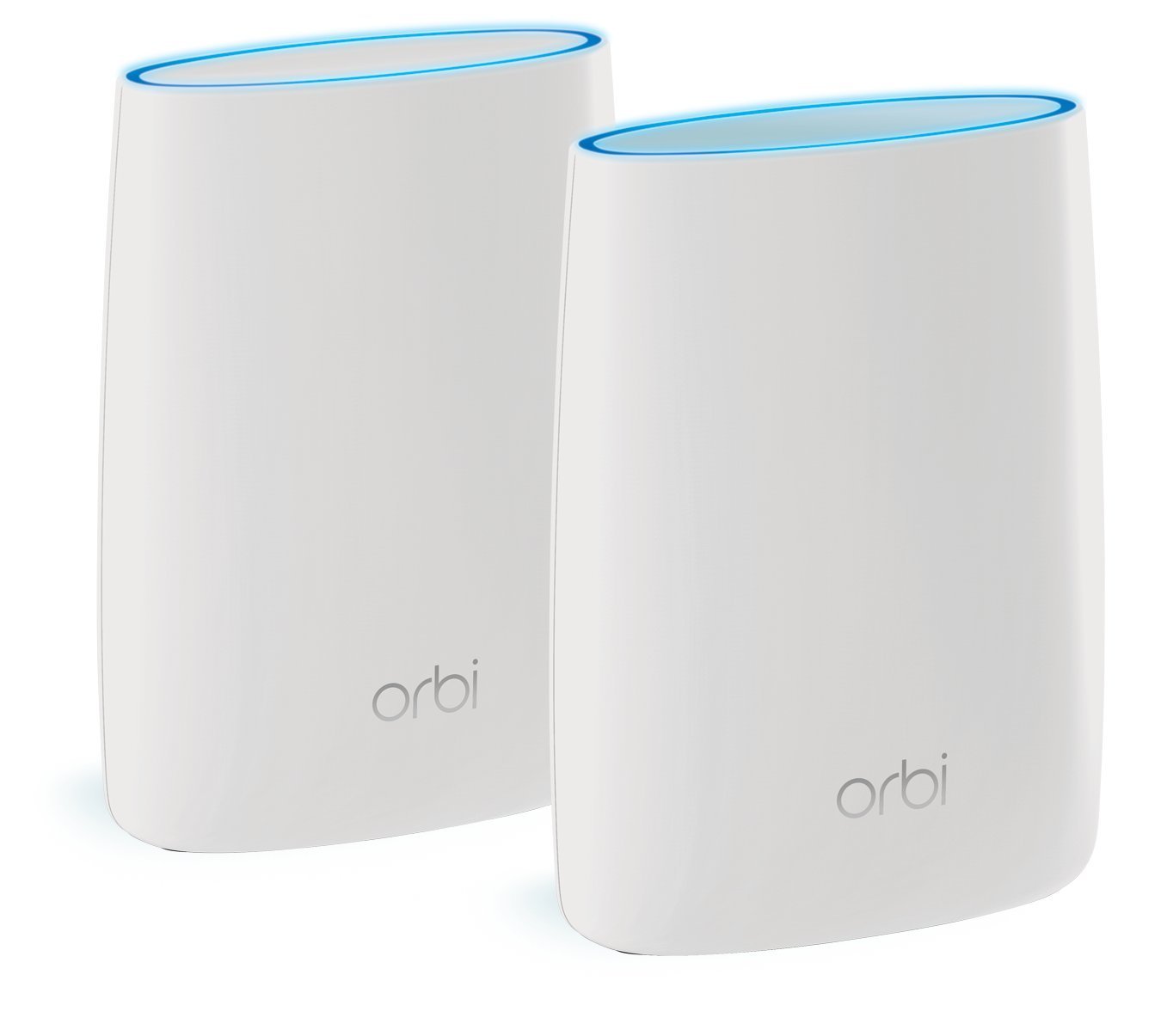
If you do not have enough power and coverage on previous models, then you should take a closer look at this model. When you buy a Netgear Orbi AC3000, you get two portable devices (router and amplifier) that connect together and provide speeds up to 1500 Mbps. This amplifier has a much larger coverage area than standard models. It is ideal for use in country houses or large offices.
Outwardly, the Netgear Orbi AC3000 looks pretty attractive, so it can be connected in a prominent place. If the amplifier does not reach the place you need, you can buy another device that will connect to the router.
pros :
- By purchasing the kit, you get a router and an amplifier.
- Very long range.
- High speed data transfer.
- Beautiful design.
Minuses :
- High price.
- You cannot chain repeaters.
Asus RP-AC68U

The main task of this device is to increase the coverage of the Wi-Fi network. It copes with this task 100%, because it provides uninterrupted connection on two bands: up to 1300 Mbps in the 5 GHz range and up to 600 Mbps in the 2.4 GHz range. Four internal antennas provide a wide range of coverage.
The device can operate in several modes: amplifier, bridge, wireless access point. Setting up a job is very simple. Sequentially press the WPS buttons on the Asus RP-AC68U router and repeater, and you can get to work.
pros :
- High bandwidth wireless network.
- Can serve as an amplifier, bridge and access point.
- Doesn't cut wireless speed.
- Unusual design.
Minuses :
- High price.
Conclusion: Which repeater is better to buy?
1. If you have a limited budget, but want to buy "the best one, and to reach the next door", then we recommend choosing TP-Link TL-WA850RE. This amplifier is ideal for a medium sized apartment. It will completely cover all dead zones when properly configured.
2. Do you want to buy something more powerful? Then pay attention to TP-Link Re350. It has proven itself excellent from the very first moment. User reviews in online stores speak for themselves. Take it, you can't go wrong!
3. Well, if you have an unlimited budget, then take the Netgear Orbi AC3000 without looking. It will provide high-speed Internet for all your Vacation home, and the connection speed will be maximum.
52 125 316
Surely you have heard of such a device as repeater wifi or wifi router signal booster... What is this anyway? The very idea of Wi-Fi is that the Internet should not be limited to one room, but spread throughout the apartment or even the backyard. But the further the distance from the wireless source, the worse its speed. And one of the devices that provide more stable operation over long distances is a WiFi repeater.
TP-Link Router Amplifier

How to strengthen WiFi signal from a router?
So, a wifi repeater, which is also called a repeater, serves to repeat the existing signal coming from an access point or router, and thereby strengthen the signal and increase the range of wifi. It has no other functions.
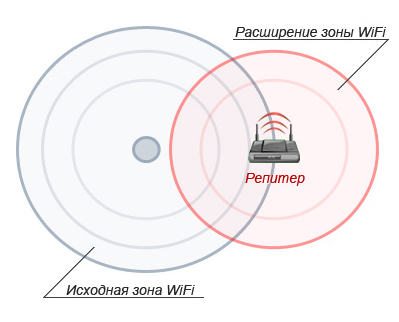
In a separate form, it looks like a kind of semblance charger plugged into an electrical outlet.
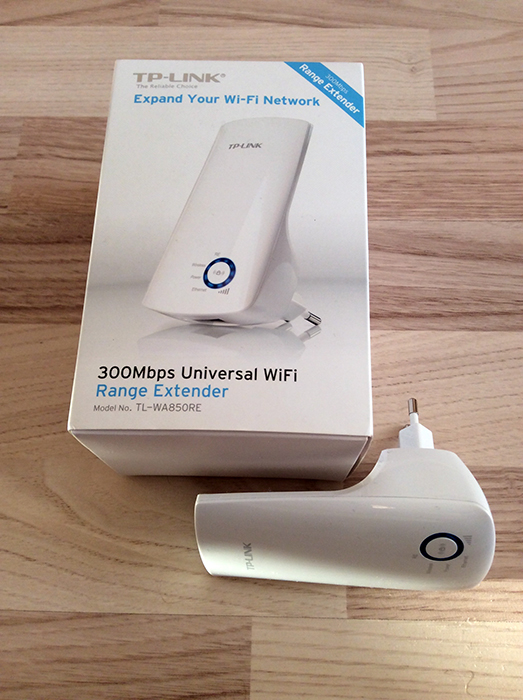
The photo shows the amplifier model TL-WA850RE(Wifi Range Extender - link to it in the online store), which was kindly provided to us by TP-LINK. He will help us today understand the intricacies of setting up a wi-fi signal amplifier - a repeater.
Here are the main technical characteristics:
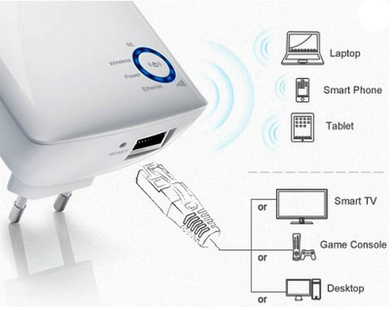
If you need to amplify the WiFi signal in a remote room, then we buy a similar piece and connect it to an electrical outlet.
- Through automatic connection to the router via WPS.
- Via WiFi using a smartphone, tablet or laptop
- Through a computer connected to it via a twisted pair.
Automatic connection of the WiFi repeater to the router with the WPS button

Like most modern models network wireless devices, TL-WA850RE supports signal tuning existing point access to automatic mode... For this, the router must also have such a function - the "WPS" button ("QSS" on TP-LINK devices) is responsible for its activation.

We press on it and on a similar large button on the amplifier, after which it should pick up wifi and start distributing it.

Setting up a WiFi router amplifier from a smartphone
I like to keep the whole process under control more, so I never use the automatic method, but I do everything manually. In order to configure the amplifier from a phone or tablet, we also press the central button of the wi-fi signal amplifier, turn on WiFi on the smartphone and find a network with the name in the list of available for connection TP-LINK_Extender_7320BA- This is the SSID that is programmed into the device by default.

We connect to it.
Immediately after the connection, we will be transferred to the authorization page in the admin panel for initial setup- a window for entering a login and password will open. By default in this model it is admin / admin - yours may have others, so look either at the instructions or on the sticker on the bottom of the repeater - as a rule, all the access data is indicated on it.
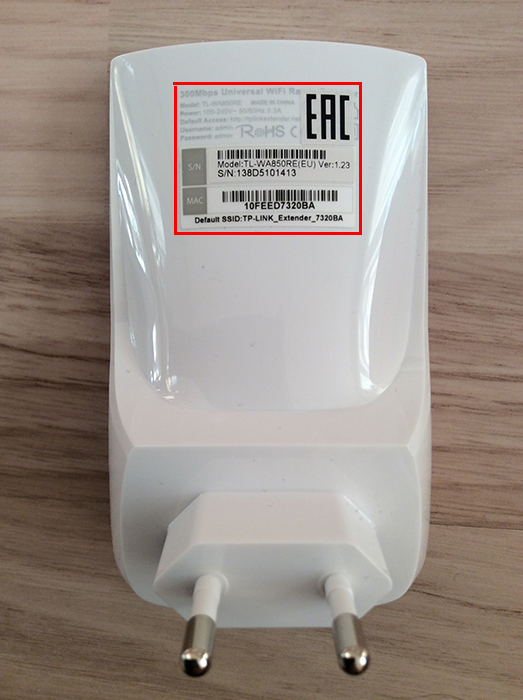
Configuring a WiFi signal repeater from a computer via a cable
This configuration option can also be done in two ways - using installation disk, which comes with a wifi repeater, or via the web interface. The second one is closer to me, so let's take it.
So, if you don't have a smartphone at hand, then we connect the computer to the repeater directly using a twisted pair - the “Ethernet” light on the device will blink.
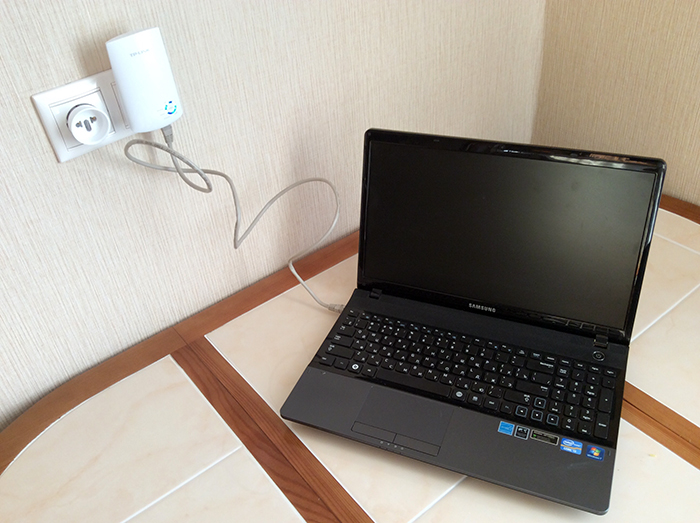
Here we need to select "Local Area Connection". Click on it right click and select "Properties". Here, as always, we are interested in the item "Protocol version 4 (TCP / IPv4)> Properties".
If you already have a local network configured through a router, then write them all down on paper and save, but for now set all the checkboxes to "Automatic":
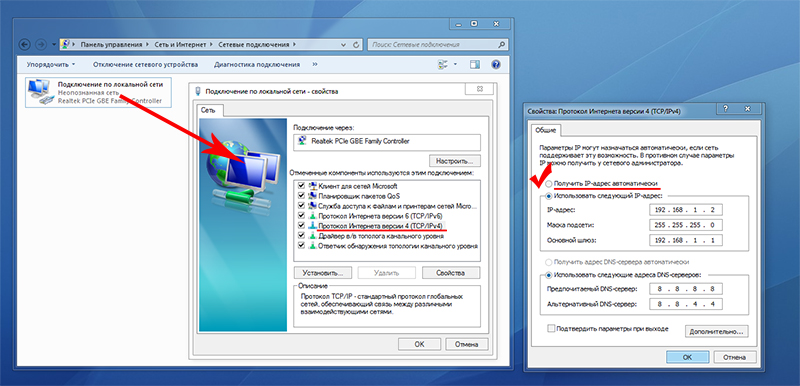
We save and go to the browser at the address http://tplinkextender.net, which we also learned from the magic sticker on the case. The authorization page, already familiar to us, will open, where we enter the login and password "admin".

We get to the admin panel. Everything is very easy here - we follow the step-by-step guide, entering the necessary data.
First, we select the country, after which the device starts scanning for available networks. If your wifi is found, select it. In the same case, if the security settings on the router hide the SSID, then you can check the "Specify SSID and MAC address manually" checkbox. And press the "Next" button.
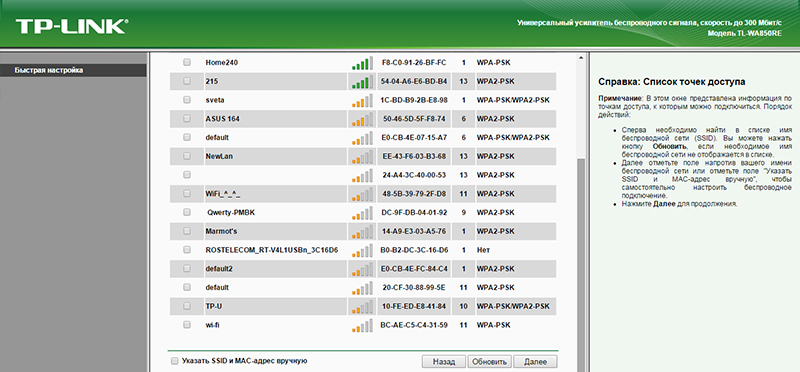
In the next step, we need to select the type of encryption for your existing network (set in the router admin panel) and enter the password from your wifi.
Here you can also choose whether the repeater will clone the name of your network (SSID) or it will have its own name, which you specify manually. In this case, the local network will remain the same, that is, your main network may be called Network 1, and the second Network 2, but in fact it will be the same, and no matter which of them you connect your PC to, it will see other devices, connected to the router.

And finally, at the last step, we see our entire configuration, after which we apply it by clicking on the "Finish" button. After the wifi reboot, the extender will start distributing the Internet from your router, thereby increasing the range of wireless signal reception.
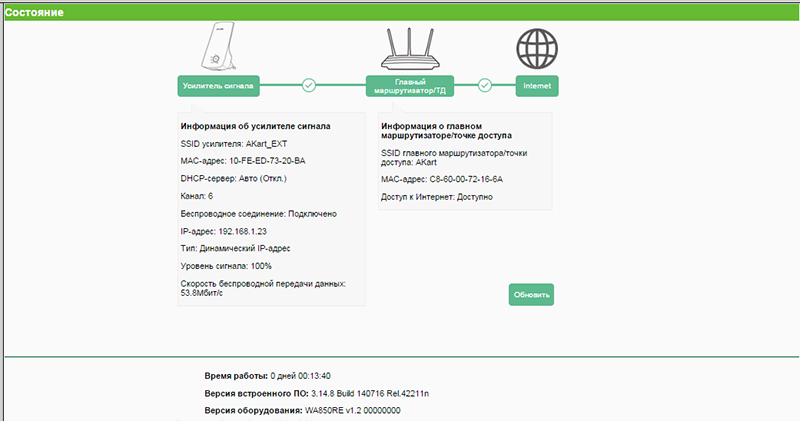
Also, after a quick configuration, the left menu will become available, in which you can configure the repeater in more detail - change the encryption key, disable the DCHP server on it, manually set the IP address, enable MAC filtering, update the firmware, view statistics, etc.

That's all there is to it. Now the network settings in the computer can be returned to their original values and the cable with which it connected to the repeater can be disconnected. By the way, if you noticed, the PC also began to receive the Internet - via cable from the repeater, that is, it can work in the same client mode, receiving the Internet via wifi and distributing it via twisted pair to the computer. Now, even in the farthest corner, you will have a stable reception!
Testing WiFi speed through a repeater
Since a new link in the form of a WiFi repeater has appeared in the chain of receiving the Internet from the provider to the computer, our review would be incomplete if we had not checked whether it cuts the speed. In other words, how different is the speed of information transfer between computers connected through this repeater from the speed when connected directly to the router.
For the test, we made three measurements inside the local network between a computer and a laptop using the AIDA32 Network Benchmark utility.
First test- this will be the starting point in our experiment - such a "litmus test". Let's measure the speed inside the local network without a wireless signal amplifier - the computer is connected to the router via twisted pair, the laptop is connected to it, but via WiFi. At the same time, for the purity of the result, there was no radioactivity near the transmitter, such as a mobile phone, TV or something else, and the laptop was located in close proximity to the router.

Here's what we got.
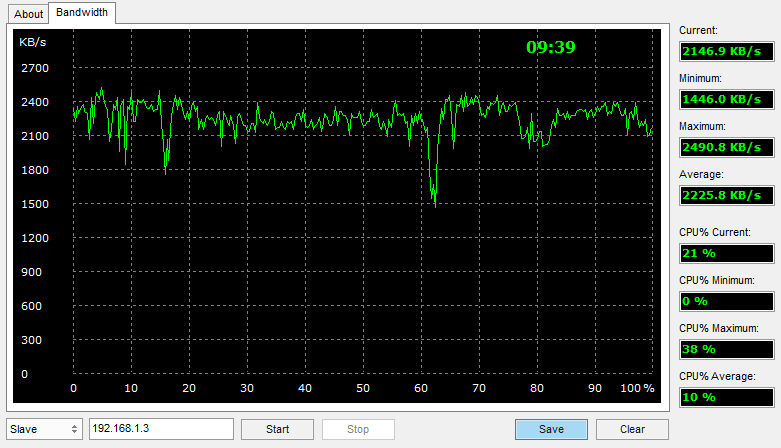
We note that there is a small amplitude of speed fluctuations, on average it was at the level of 2200 KV / s (17 Mbit / s).
Second test- the computer remains connected to the router via a cable, and the laptop via WiFi to the repeater, which we made our own SSID of the network, so it is impossible to confuse it with the signal from the router. In this case, the repeater and the laptop were in the same place, that is, next to each other.

Result:
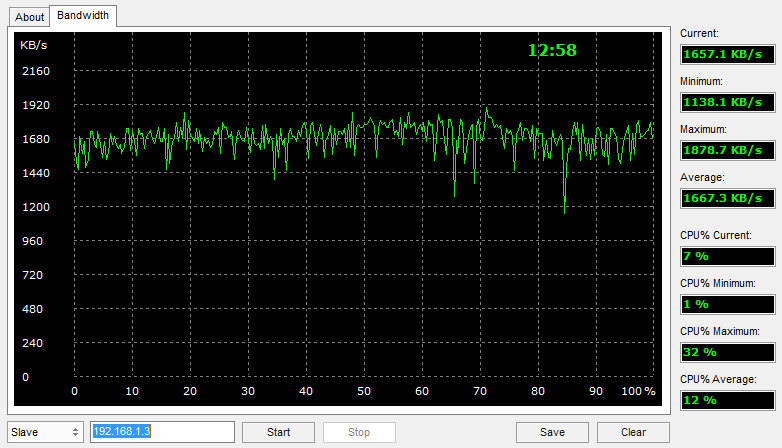
The speed dropped slightly - on average, up to 1600 KV / s (12.5 Mbit / s). Also, the spread between the minimum and maximum values does not differ much, which is also very good.
Third test- the laptop was left connected via WiFi to the router, and the PC - through an amplifier, but connecting them with a patch cord. Thus, we will use the second opportunity of this model - to act as a WiFi adapter.

We get:
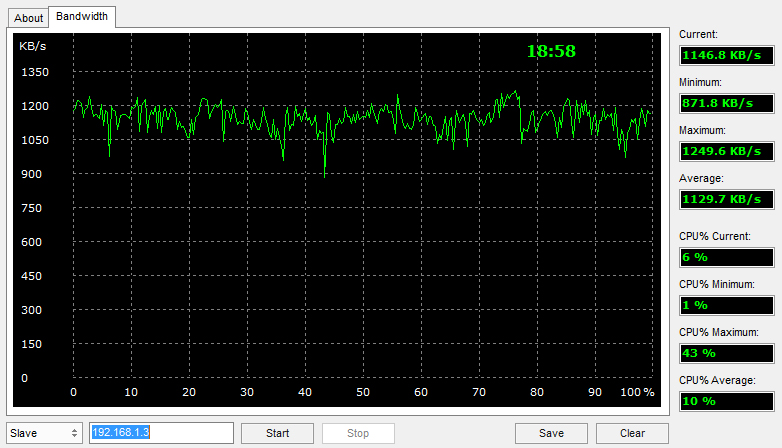
Fluctuations between the minimum and maximum values are also insignificant, that is, the connection is quite stable, but the overall speed has become a little bit lower, up to 1100 KV / s, or 8.5 Mbps.
Finally, fourth test- we connect both the PC and the laptop to the repeater, but the stationary computer with a cable, and the laptop wirelessly.
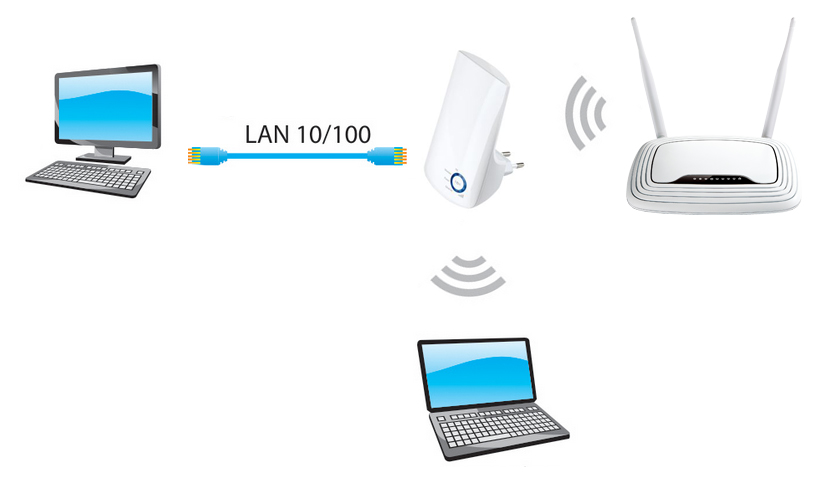

Unstable speed with large fluctuations, average high - at the level of 4800 KB / s = 37.5 Mbps.
Summarize... As you can see, the presence of one more link within the local network between two computers in the video of the wifi repeater still lowers the overall speed, which was not a surprise for us, since the presence of any additional device, be it a repeater, powerline or some other adapter, will influence her. The most interesting thing was to see in which particular mode these losses would be the least.
As it turned out, the highest average speed was with the scheme (No. 4), when computers were connected to each other through a repeater, bypassing a router - 4800 Kb / s compared to 2200, which was given by WiFi without a repeater. This is quite logical, since between them there was no extra "knee" in the chain, in the form of a router, the role of which in this case was played by today's hero. Although the spread between the highest and lowest values is a bit strenuous, the connection does not differ in stability.
But most of all of this test questions arose to my ASUS router RT-N10U - why does it only give out 2 MB per second ?? It turns out that in my network he is the weakest link - it is worth thinking about how, as in one well-known program, to say goodbye to him and look at another model.
The second place in terms of speed was given to scheme No. 2, in which one of the computers was connected to the router using a patch cord, and our repeater sent out a signal to the laptop. Although, as we found out, a router played a disservice to us here, but this does not affect the overall picture, since after that we tried to use TP-LINK as an adapter (No. 3), receiving a wireless signal and sharing it on a PC - with this he did the worst.
Amplifier range
As for the distance that this repeater model extended the signal from the main source and boosted WiFi. I connected it in a room farthest from the access point in an ordinary "Brezhnev" treshka - it turned out that it directly passed through 3 plasterboard walls at a distance of about 10 meters. In this room, the Internet did not even catch iPad Air, to the wireless module of which there are no complaints - it sees wifi even where it is no longer on other smartphones. Our Extender from TP-LINK also caught it (two antennas make themselves felt). And without any problems he began to extend it as far as the staircase. I agree that initially the location of the Point is not very successful, but for our experience it is just the right place.
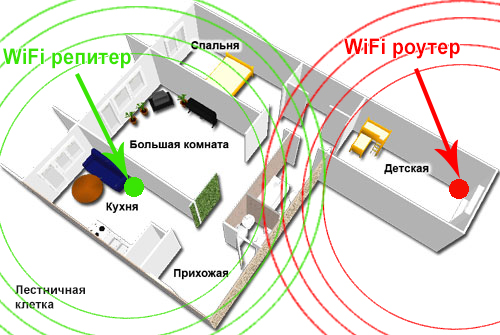
In numerical form, this is expressed as follows. When there was no repeater, in the far corner of the apartment, the Internet speed from the router was as follows:

When we connected the amplifier, we got this:

Of course, these results are relevant only for my network - they were influenced by the characteristic network card A PC, and a wireless module of a laptop, and hardware of a router, and even a radio-magnetic environment in a room, which we brought as close as possible to a calm, everyday one. But they certainly represent the big picture, so you can safely use these conclusions in your practice when designing your networks.
Well, TL-WA850RE did an excellent job with its task, and I can recommend it to my subscribers as an effective way to expand the coverage of your WiFi.

A repeater mode router is a pretty useful device whose purpose is to extend i.
There are many articles on the Internet about how such a device works and where you can get it.
But most of these do not really answer the question, but only confuse users even more. We, in turn, will try to explain complex things as much as possible. simple language... Let's start with how it works.
What is a repeater
The repeater is translated from English as "repeater". To put it simply, this is a device that catches and distributes it further. Thanks to this, the coverage area of the router is increased. As for how much it increases, this indicator depends on the characteristics of the repeater and router.
Clearly, it all looks like the one shown in Figure 1.

Rice. 1. An illustrative diagram of the repeater's work
On the left is the router from which the signal is coming. This signal goes to the repeater, which is located in the middle and also emits the signal received from the router. Thus, the desired effect is achieved - the signal coverage area increases.
There are a huge number of both routers and repeaters on the market. One of the most popular models the latest TP-LINK RE200, which costs approximately $ 400. It has the following characteristics:
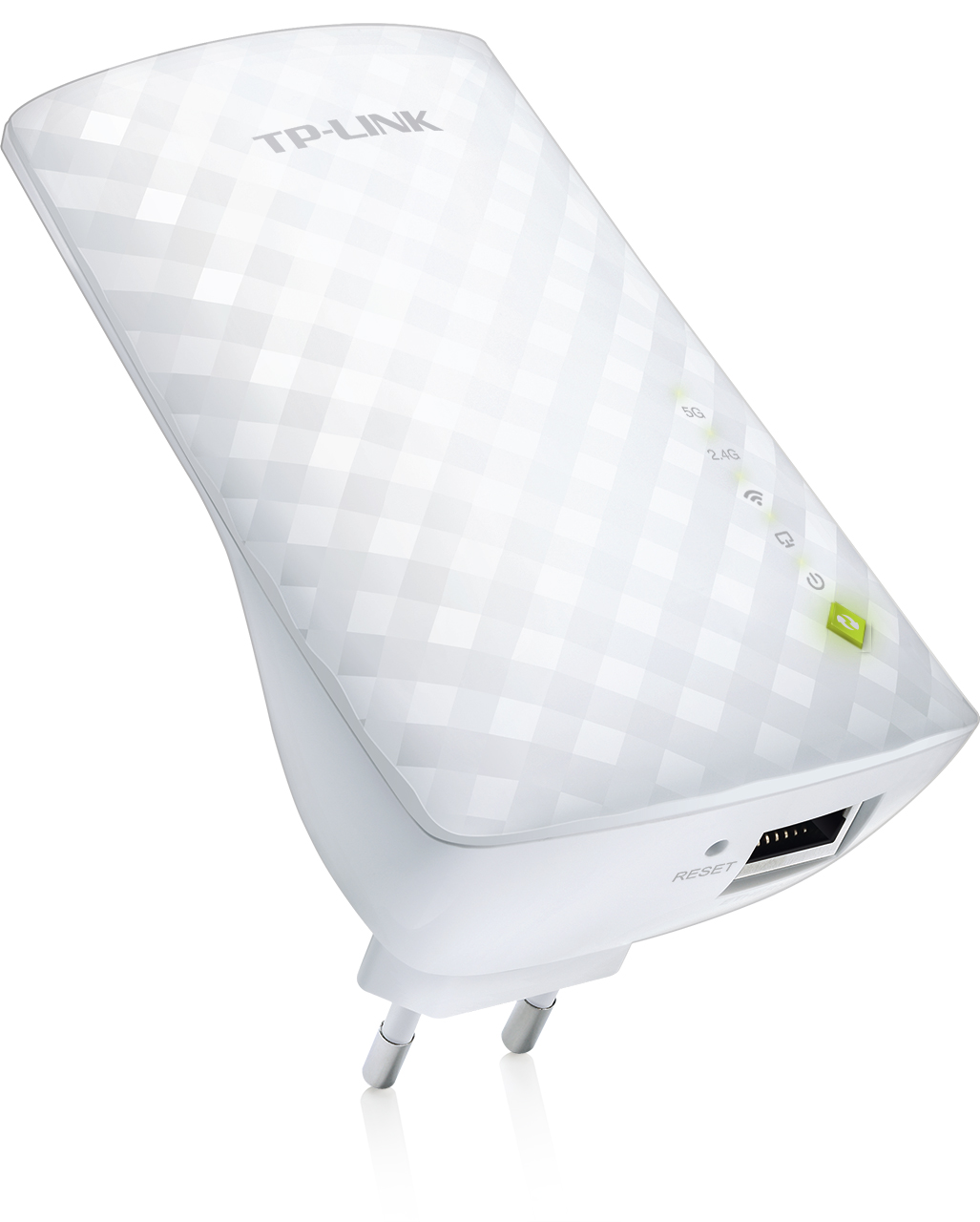
Rice. 2. TP-LINK RE200
It is important that this model is dual band. This means that if you use the same (2.4 GHz and 5 GHz frequencies are used), the repeater can easily repeat its signal.
As you can see, the repeater plugs into an outlet and has a connector for the tip. The WEB interface is used for configuration. It should be said that everything was done very conveniently and well. Any user can easily configure this device.
So, we figured out what a repeater is. Now let's get back to where we started. The fact is that a router can also be used as a repeater.
Important! There is only one criterion for determining whether it is possible to use a particular router model as a repeater, and it consists in whether the manufacturer has laid such a possibility. If the developers specific device it was originally assumed that it could be a repeater, which means that it can be used that way. And if they did not anticipate such a possibility, it is impossible to remake the router so that it appears. If you try to do this, you can just break the device.
If you show this one in the same diagram as shown in Figure 1, then on the right, instead of a repeater, there will be another of the same router. That's all!

Rice. 3. Scheme of using a repeater with a router as a repeater.
As you can see, everything is quite simple to understand. But there are a few more points that should be clarified. It is about this:
- Despite the fact that two devices are used, the network is still one. This is also true for cases when the router is used as a repeater. The functions of the repeater, among other things, include copying information from the router.
- All devices that you connect to Wi-Fi will connect to the device with the stronger signal. But you won't notice it. However, from the user's point of view, it doesn't matter whether the same one connects or to a repeater. The main thing is that the signal will be enough for the full use of Wi-Fi.
- A repeater (as well as a router in repeater mode) allows you to organize, which will include all devices connected to Wi-Fi.
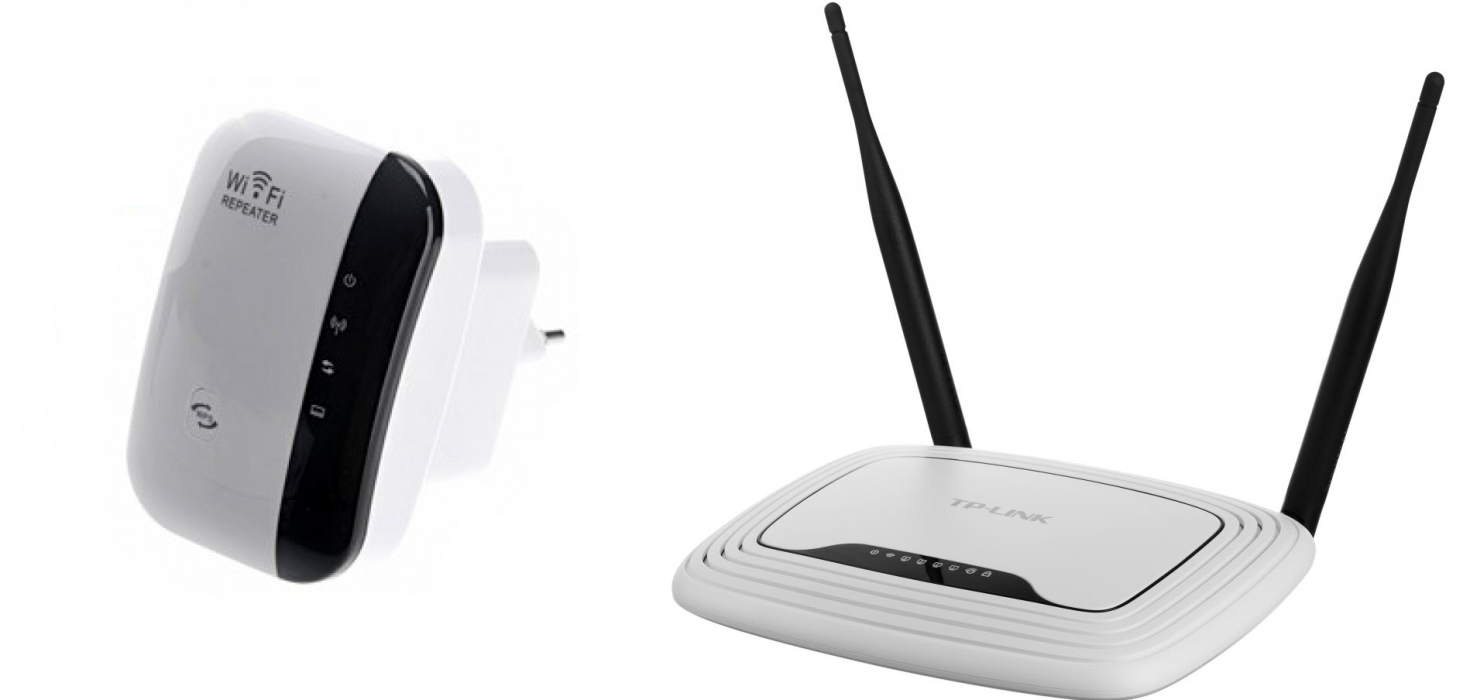
Rice. 4. Repeater and router
Benefits of using a repeater
The main advantage of a repeater is that you can provide a large area of the room with a Wi-Fi signal. In addition, using a repeater has the following advantages:
- the aforementioned possibility of organizing a local network with all devices that are connected to Wi-Fi;
- regardless of the number of repeaters, all devices that will connect to the signal will use the same check (the same password);
- in some cases, the repeater can even amplify the signal of the router (but usually only certain models have this capability and you need to find out about this from the manufacturer or the consultant of the hardware store).
But, basically, the repeater is used in order to solve the problem with. A simple everyday situation, when the Internet does not catch in the bedroom or in the kitchen, is easily solved using a repeater or a second router that can be used as a repeater. Now it makes sense to talk about how to configure the second router so that it can. But before that, it is worth clarifying a few points regarding the cases in which you can use the router as a repeater.
When is a router suitable for use as a repeater?
Experts agree that it makes sense to use it in this way only when you have unnecessary one. In other cases, it is better to purchase a full-fledged repeater. And there are several reasons for this, namely:
- it is far from always possible to provide a signal of the same quality as that emanating from the main router;
- signal stability can also often suffer;
- also, it is far from always possible to successfully complete all the manipulations to set up such a connection the first time.
The problem is that each router is configured in a completely different way, although there is a certain general algorithm for performing such actions.
2. Then go to the "Wireless" section or "Wireless network"... There, find the line "Channel", that is, "Channel". All we need to know in this case is that the value of this parameter must be the same on both routers. For example, let's set it to "6".

Rice. 5. Configuring wireless settings
3. This completes the setup of the first device. Then connect the second to the computer using a cable, go to the settings (just as we said above) and open the "" menu. In it, click on the "Disable WPS" button. We will not go into details of what it is.
4. Reboot the second router, that is, unplug it and plug it back in. The same can be done by clicking on the "click here" message that appears after the previous step.
5. After that go to the "Network" menu and the "LAN" submenu. In the "IP Address" field, enter the new IP address. It should be more than the one that was, by one. That is, it was originally 192.168.0.1, but now you need to enter 192.168.0.2, as shown in Figure 6. Click the “Save” button to save the settings.
6. Now enter the address that was specified in the previous step in the address bar.

Rice. 6. The first stages of configuring the router in repeater mode
7. The previous step will allow you to go back to the settings of the second router. Go to the "Wireless" section and the "Wireless Settings" subsection again. There we will be interested in the following parameters:
- "Wireless Network Name" - the name of the network that the second router will distribute;
- "Region" - the region (the country in which you live);
- "Channel" - the channel (we said above that we will take its value 6 as an example);
- "Enable WDS Bridging" - just check the box, this is the item that enables WDS.
8. Click on the "Survey" button to continue.

Rice. 7. Configuring the second router and connecting to the first
10. After that, it remains to enter the password for the network to which we are trying to connect. To do this, enter the type of encryption used in the first router (this is done in the "Key type" field). Then enter the password in the “Password” field and click the “Save” button to save the changes made.

Rice. 8. End of connection of the second router to the first
That's all! The network should now work fine.
Hint: WDS is a repeater mode.
Hard enough.
But from the entire procedure described above, you can extract the same algorithm that is suitable for connecting any two routers and using the second as a repeater. It looks like this:
- at the first turn on the possibility of using its signal by the repeater;
- we put the same channel on both (although this is not always necessary, but if there is a corresponding item in the settings, specify its value);
- connect the second to the first in repeater mode;
- we use.
The procedure outlined above is shown using routers as an example. In some cases, there is an item called "Repeater" (not "WDS"), if the device settings have a Russian interface. It can be in many different sections, so you have to look for it. But be that as it may, if this item is, you can definitely find it.
What if nothing comes of it?
If something doesn't work out for you, there are several options:
- Try all the above procedures again from the beginning.
- Write in the comments under this article at what stage you have problems, we will definitely help you.
- Contact the manufacturer of the devices (at least one of the two) you are using for help.
- Call a specialist from your provider at home. These people should help their clients use the Internet in a way that suits them.
But there are not so many manipulations as it might seem at first glance, so even a novice user can perform all of them. The main thing is to follow the above algorithm and adhere (at least approximately) to the order of actions, which we also talked about earlier. Success in setting up!
About the non-standard application of the electrical network at home: using the TP-Link Powerline adapter, we threw Wi-Fi through the outlet.
In the comments, I was asked why for such an elementary action I did not use the usual WiFi repeater... Well, today we will figure out how such a thing works, what are its pros and cons.
Theory
As I said in the last article, the use of the PLC was due to the foul Wi-Fi air and the transfer of the "mother" point to the 5GHz range, in which the wall penetration deteriorated greatly.The scenario for using Extenders is somewhat different. Instead of using the "unbroken" channel "inside the socket" for forwarding the network where it is impossible to spoil the walls and floor by laying a cable, we use the corny space of the apartment / house / office: we take the point where the Wi-Fi reception is so-so, point, where there is a router, and approximately in the middle we hang Extender or Repeater or call it whatever you want. He takes Wi-Fi where the reception is still strong enough and repeats the signal to where the "native" source no longer finishes.
In this case, the repeater works in the same channel as the source, and, as a consequence, somewhat reduces the overall speed for both the mother access point and for itself. Ideal will be the conditions of "direct radio visibility" between the point of interest to you and the repeater, repeater and router.
Practice
Take a Wi-Fi repeater as an example. Upvel UA-322NR... In Yulmart, this particular manufacturer is not currently available, but there are many other options, for every taste and wallet size. I do not think that any TP-Link or ASUS will be very different in characteristics or capabilities. The general principle of operation is approximately the same, as well as the scope of delivery.
The box is neat, everything is in Russian and perfectly localized, even a child can handle the installation. Inside is the device itself, a small ehternet cable, bright and clear instructions on initial setup and miniCD with additional information and software.
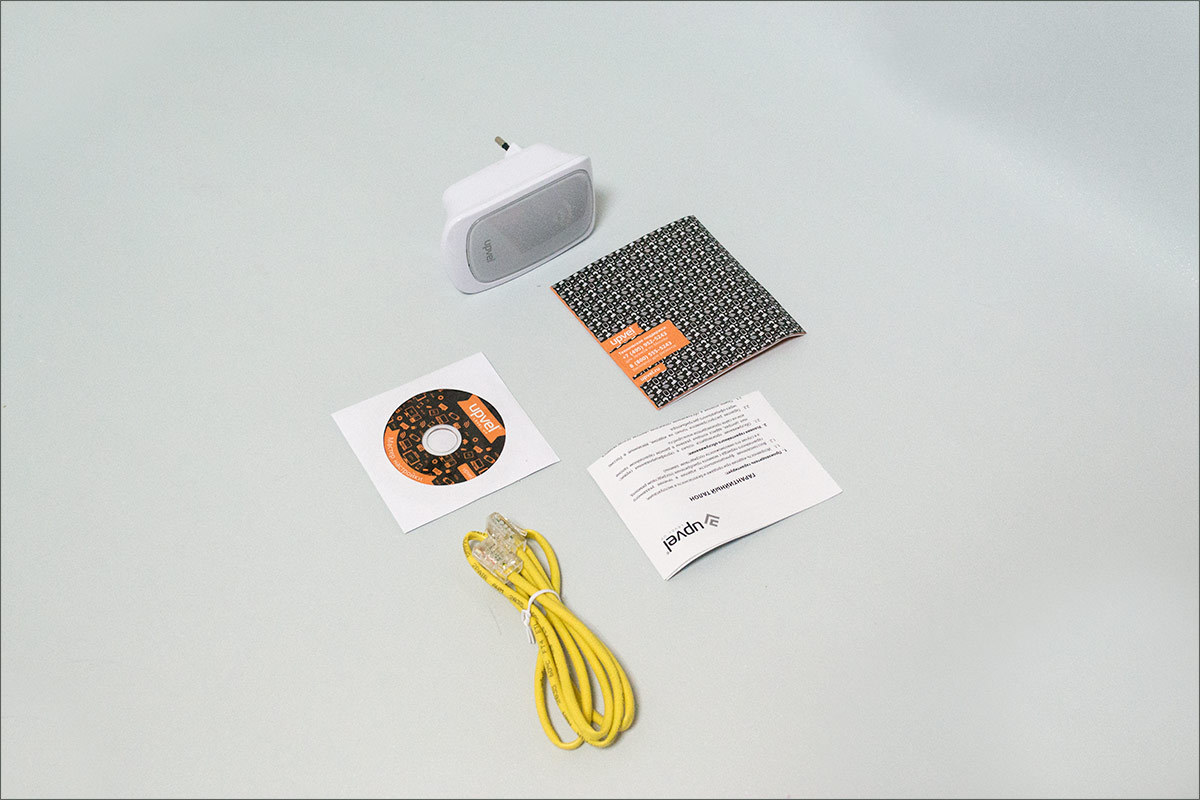
 The gadget itself, in fact, consists of an Ehternet port, a WPS button, a small "pin" Reset button, a reception level indicator and a socket for an outlet.
The gadget itself, in fact, consists of an Ehternet port, a WPS button, a small "pin" Reset button, a reception level indicator and a socket for an outlet.
After initial setup The gadget was moved to a room that needed to be "lengthened", but there the signal level (and, accordingly, the speed of work) were at the minimum available values, and there would be no effect of extending such a weak network.
Therefore, experimentally, in an adjacent room with a normal reception level, a position was found in which the signal level for the repeater was at a sufficient level, and at the point where the Internet was needed everything started up at normal speeds.
Since then, the device has worked for six months without interruption, and after a while a wired digital TV receiver was added to it: fortunately, the Ethernet port can be used not only for setting up, but also for distributing Wi-Fi to those devices that cannot access the network via wireless channel, but have a regular Lan-port.
We measure the speed
In order not to be unfounded, here are the graphs. This is how Wi-Fi worked before installing a repeater in distant rooms:
As you can see, the Internet is barely a soul in the body, and it doesn't smell like speed. With the installation of a repeater in the desired room, the reception level increased greatly, but the speed - for obvious reasons - did not, since the repeater was repeating an already pretty dry signal. But after rearranging the repeater in the "correct" place, selected empirically, the signal quality has increased, the speed can be called acceptable. 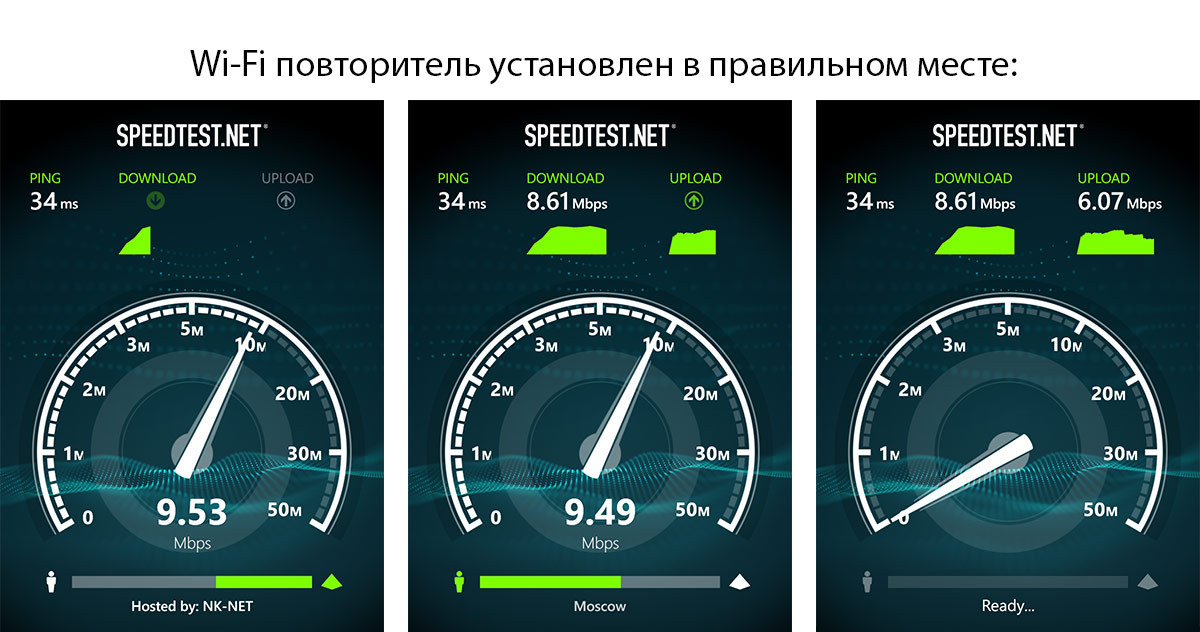
You don't even need to comment on the result. At the same time, next to the router itself, you can measure not much more, and the speed loss when the repeater is connected to the network was about 10-15%: 
As for the Upvel repeater, here I see one big plus. Maybe he is also "Chinese" inside, but this did not affect the quality of work, and localization and execution of instructions will allow even users who are quite far from high technologies to cope with the expansion of the network.

And so - it works, has been working for a long time and without problems, what else is needed? :)
General summary
A Wi-Fi repeater is not a panacea, and it will not be able to raise the speed to the "original" one, which quite logically follows from the methods of its operation. But when you need to forward Wi-Fi a little further or hook onto Wi-Fi with a purely wired device, it can help out.Among the models that
Often after installing the router wireless network does not cover the entire area of a home or office. In such cases, an amplifier is needed. In order not to spend a considerable amount on the purchase of a device, it is easier to make a wi-fi signal repeater with your own hands.
What is a Wi-Fi Repeater? The English word repeater translates as - repeater. The repeater connects to the existing network and receives a signal from the wi-fi router, which repeats (repeats) further. At the same time, the coverage area of the network is significantly expanding. If earlier there was no Wi-Fi coverage in some place remote from the router, then after installing the amplifier a stable Internet will appear there.
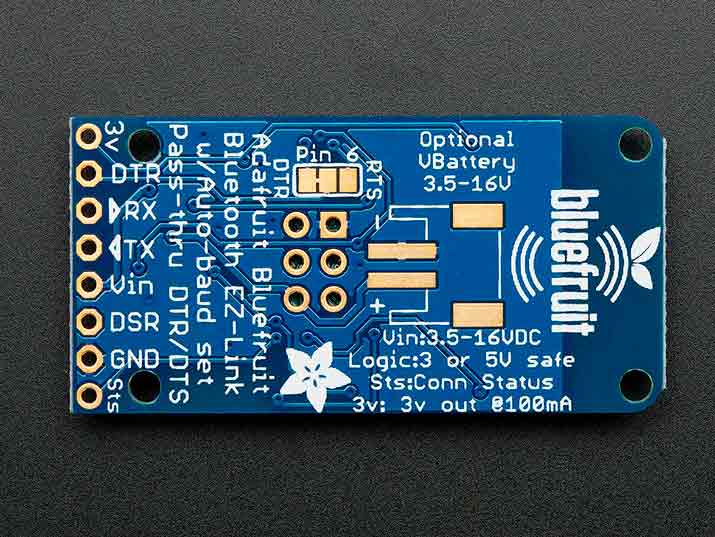
In the case of using a wi-fi repeater at home or in an office, there is no need to purchase and install expensive and complex equipment, pull an additional cable. It is enough to purchase an amplifier and plug it into an outlet. In this case, the range of the network will immediately increase several times.
As far as the performance of the repeater is concerned, things are not so optimistic here. A small disadvantage of a wi-fi signal repeater can be attributed to a decrease in the speed of the Internet.
Some devices may restrict data transfer from 3 to 5 Mbps. This speed reduction is not critical. The signal strength is quite enough for watching movies and surfing the World Wide Web.
How to make a repeater from a wi-fi router?
If there is an unnecessary router, then a wi-fi repeater can be made by hand. To do this, in the settings of the main router, we change the number of the transmission channel. The number can be anything, but it must be remembered. This value will be needed when configuring a router that plays the role of a relay. Everything changes made save.
The next step is to create a wireless bridge between the main router and the repeater. To do this, you need to connect the devices using a network cable.

Repeater from Wi-Fi router
How to set up a DIY wi-fi repeater:
- using a computer, enter the admin panel of the router (repeater) by entering your username and password;
- find the section " Wireless connection"And go to the" Operation mode "settings;
- after selecting the “Universal repeater” mode, press “Search”. The program will itself find the main router and connect to it;
- in the "Channels" window, enter the number that you specified when setting up the main router;
- select your preferred encryption algorithm and reboot.
After all the steps, the wireless network is ready for use. It is desirable that the router with a wi-fi repeater working in conjunction are of the same brand. This will greatly improve network performance and stabilize the signal.
Connecting and checking the operation of the amplifier
To assess the correctness of setting up the repeater, you need to connect it to a laptop or computer using a LAN cable or Wi-Fi and power it from the mains.

We connect the repeater to the computer
- click "Start", enter the "Control Panel" and "Network Control Center";
- we find subsections "Changing adapter parameters", "Local area connection", "Properties";
- open the line "Internet Protocol version 4 (TCP / IPv 4)" and check the used IP address. It must match the IP of the repeater;
- then in the search bar of the browser, enter the IP address of the repeater and go to the admin panel. All Wi-Fi repeaters have one login and password by default - the word "admin". We enter it in both fields;
- by opening the "Networks" menu, we will see all the available connections. Choose the one you want and connect.
The wi-fi repeater mode and baud rate can be checked in the Status menu.
Owners Android smartphones can test the operation of the amplifier by running the software on the device WiFi Analyzer... If the repeater and wireless bridge are configured correctly, you will see two access points with the same name and operating on the same channel on the screen.
Principle of operation
How does a wi-fi repeater work? The principle of the amplifier is simple. For example, there is a functioning router that distributes wi-fi indoors. Everything works, but not everywhere. There is communication in the rooms, but in the corridor the signal is worse or not at all. In this case, a repeater will come to the rescue.
How does it work: receiving a signal from the main router, the repeater sends it further, expanding the network coverage area. And now, in the hallway there is already an Internet connection. Thus, the repeater repeats and amplifies the wi-fi signal.

Repeater to enhance Wi-Fi signal
There are several important points to consider when using an amplifier:
- if you install a repeater, then the home wifi network it will still be a single one, with one login and password, since the device copies the existing network;
- all home devices will be able to connect to a stronger network by themselves;
- smartphones, tablets, computers and other devices will be connected to the main router and located in the same zone.
Application wifi repeater will help you create a home local network or your DLNA server that will allow you to watch movies from your PC on your TV. It does not matter which gadget is connected to the router and which to the amplifier.
A wi-fi repeater is a very useful and necessary device. If it is properly connected and configured, Internet access will appear in the most remote corners of an apartment or office. Wi-fi will work stably and without errors that often appear due to low signal strength. In addition, it is not necessary to buy a repeater. You can do it yourself, saving money and time.
